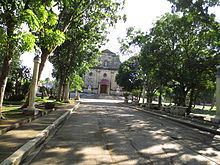Barangays Elevation 55 m Urban area 4.15 km² | Demonym(s) Ilonggo: Dingle-anon Area 98.37 km² Area code 33 | |
 | ||
Founded 1593 (parish)1823 (Town of Dingle)1907 (Municipality of Dingle) | ||
Filipinos celebrate pride for dingle iloilo
Dingle is a third class municipality in the province of Iloilo, Philippines. According to the 2015 census, it has a population of 45,335 people.
Contents
- Filipinos celebrate pride for dingle iloilo
- Map of Dingle Iloilo Philippines
- Drew arellano takes on nautod wall in dingle iloilo
- History
- Geography
- Barangays
- Demographics
- Power
- Water
- Bulabog Putian National Park
- Mt Manyakiya
- Historical
- Other landmarks
- Festivals
- People
- References
Map of Dingle, Iloilo, Philippines
Drew arellano takes on nautod wall in dingle iloilo
History
Dingle started as a pre-colonial settlement of Sumandig, which was under the jurisdiction of Simsiman, a pueblo of Laglag. The settlement was also known as Sibucao, Ba-ong and Orvat. The Augustinian priest, Fr. Francisco Manuel Blanco, first founded Dingle as a visita of Pototan in 1593. Dingle became independent on April 23, 1611. In 1629 however, it was annexed to Dumangas, Iloilo and to Dueñas, Iloilo in 1641 (until 1825). On August 16, 1850, by order of Governor General of the Philippines Antonio de Urbiztondo, Dingle again became independent and was officially named the town of Dingle. The first town head was Julio Dator (1823–1827). In 1865, Fr. Fernando Llorente ordered the construction of the Dingle Catholic Church which was completed in 1886.
During the second phase Philippine Revolution against Spain, during the Spanish–American War, Dingle staged the first armed uprising in the Province of Iloilo. Now known as the "Cry of Lincud", the revolt occurred in Barrio Lincud on October 28, 1898. Today the event is commemorated as a special non-working holiday. The leaders of the uprising were Adriano Hernandez, Julio Hernandez, and Nicolas Roces. Adriano Hernandez later became a brigadier general in the Philippine Revolutionary Army. He then represented the province at the Malolos Congress. Later, he was appointed Director of the Bureau of Agriculture. Today, his statue stands inside the Philippine Army's Camp General Adriano Hernandez in Dingle, which is named in his honor.
Under the Americans, Dingle was annexed to Pototan, Iloilo, the latter being larger and more prosperous. Nonetheless, thru the efforts of Gen. Adriano Hernandez, the separation of the town from Pototan was given impetus in 1907.
In 1954, the sitio of Nazuni was converted into a barrio and was added as a barangay of Dingle.
Geography
The topography of Dingle is relatively rolling hills and narrow plains from the Poblacion. The flat lands extend along the Jalaur River through its borderline to the southeast. This starts to roll upward from the Poblacion going to the north-west. From the west of the Poblacion rises the slopes, steep and mountainous. This indicates that the topography of Dingle meets a certain type-cropping pattern.
Barangays
Dingle is politically subdivided into 33 barangays.
Demographics
In the 2015 census, the population of Dingle, Iloilo, was 45,335 people, with a density of 460 inhabitants per square kilometre or 1,200 inhabitants per square mile.
Power
The Panay Diesel Power Plant located at Tinocuan, Dingle provides 110 megawatts of energy to Panay. The power plant is operated by the National Power Corporation
Water
Two natural springs, the Lubong-Tubig and Talinab, serve as water source for the Dingle-Pototan Water District. While the Jalaur Irrigation Dam also known as Moroboro Dam, built in 1955, provides irrigation to the agricultural lands of Dingle and nearby towns.
Bulabog Putian National Park
Bulabog Puti-an is the only limestone rock formation on Panay. It was designated a National Park through Congressional Bill No. 1651, and such is considered a "nationally significant area." It occupies a land area of 834.033 hectares covering five of the 33 barangays of Dingle. The park contains 13 known caves namely : Lungib, Hapu-Hapo, Ma-arhong, Guiso, Maestranza, Linganero, Lapuz Lapuz, Ticondal, Butac, Tuco, San Roque, Pitong Liko and Nautod. The Maeztranza Cave is historically important as it served as a hide-out of the revolutionary forces during the Spanish colonial period and on its stone walls are inscriptions of the revolutionary troops.
Mt. Manyakiya
Mount Manyakiya is a natural viewing deck that provides a panoramic view of Negros Island as well as the low lying towns of the province of Iloilo. Nautod Wall, one of the major rock-climbing destination in the Philippines, can be found here.
Water
Historical
Other landmarks
Festivals
The Dingle Town Fiesta is celebrated every 24th day of June in honor of its patron saint, John the Baptist.
The Pagdihon Festival is a celebration in commemoration of the Cry of Lincud, the first revolt against the Spaniards on Panay. It is held every 4th week of October.
